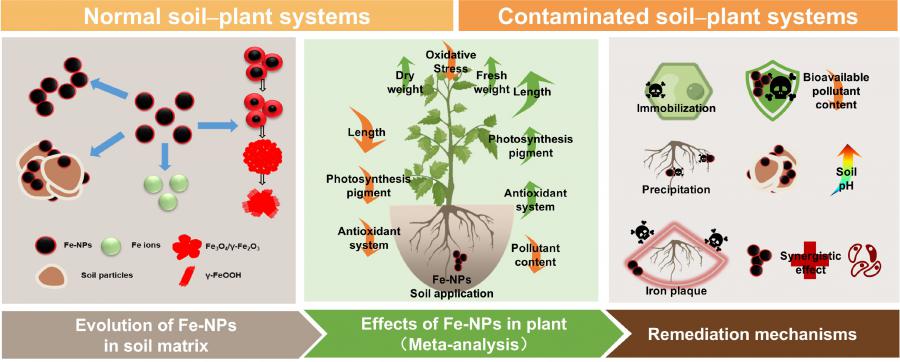
Iron-based nanoparticles in agriculture: promise, peril, or paradox?
GA, UNITED STATES, May 12, 2025 /EINPresswire.com/ -- A sweeping new analysis unpacks the complex role of iron-based nanoparticles (Fe-NPs) in agriculture, revealing a delicate balance between benefit and risk. Synthesizing findings from 57 peer-reviewed studies, researchers examined how Fe-NPs influence plant growth and soil health, especially under polluted conditions. The results are striking: these particles can enhance plant biomass and limit pollutant absorption, offering new tools for remediation. Yet, at higher concentrations, they may hinder plant pigment production and disrupt soil microbiomes. As scientists race to unlock the potential of nanotechnology in farming, this study provides a critical roadmap for using Fe-NPs safely and effectively.
Soil contamination, fueled by rapid industrialization and urban sprawl, continues to threaten global food systems. Toxic elements like heavy metals and organic pollutants degrade soil quality, suppress crop yields, and risk entering the food chain. Amid these challenges, nanotechnology has emerged as a promising solution. Iron-based nanoparticles, in particular, have been spotlighted for their potential to clean soils and promote growth. But their safety remains a matter of debate—some studies praise their benefits, while others flag toxicity concerns. Due to these contradictory findings, a comprehensive evaluation of Fe-NPs in diverse soil–plant systems is urgently needed to guide future use.
To address this gap, a research team from China Agricultural University and Peking University conducted a detailed review and meta-analysis, published on December 12, 2024, in Frontiers of Environmental Science & Engineering. The study explores how Fe-NPs interact with soil matrices, influence plant physiology, and mediate pollutant dynamics. Drawing on data from 57 studies, the researchers offer a nuanced perspective on Fe-NPs as both a nutrient-enhancing agent and a potential environmental risk factor.
The analysis paints a complex picture. In both clean and contaminated soils, Fe-NPs increased fresh and dry biomass and enhanced iron uptake. However, high doses—particularly of nano zero-valent iron (nZVI)—led to reduced plant height, signaling possible toxicity. In contrast, oxide-based forms like Fe₂O₃ and Fe₃O₄ showed safer profiles at moderate levels (10–100 mg/kg). In polluted soils, Fe-NPs proved valuable, lowering heavy metal and organic pollutant levels in plants. Still, negative effects on photosynthetic pigments in uncontaminated soils raised red flags. Mechanistically, Fe-NPs interact with soil particles, oxidize, and are absorbed by plant roots as particles or ions, ultimately accumulating in roots and shoots. While some trends suggest promise, the absence of long-term data on edible yield and ecological impacts signals the need for more research.
“While Fe-based nanoparticles offer great potential for sustainable agriculture, their application must be precisely controlled,” said Dr. Xiao Zhao, corresponding author of the study. “Our findings emphasize the importance of dosage, nanoparticle type, and soil conditions. With proper regulation and further research, Fe-NPs could be harnessed to enhance food security and reduce environmental pollution—without introducing new risks.”
Looking ahead, the study positions Fe-NPs as a double-edged sword in environmental and agricultural applications. Their remediation abilities and growth-promoting effects make them attractive for phytoremediation and precision farming. However, their risks—ranging from impaired crop function to disturbed microbial communities—necessitate careful management. Future work should refine nanoparticle formulations, assess long-term impacts, and decode interactions across plant, soil, and microbial systems. With robust oversight and scientific rigor, Fe-NPs could support cleaner soils and healthier harvests in an increasingly stressed agricultural landscape.
References
DOI
10.1007/s11783-025-1947-1
Original Source URL
https://doi.org/10.1007/s11783-025-1947-1
Funding information
This work was supported by the National Natural Science Foundation of China (Nos. 52279051 and 52261145701), the 2115 Talent Development Program of China Agricultural University (No. 109018), and the Chinese Universities Scientific Fund (No. 2024TC027).
Lucy Wang
BioDesign Research
email us here
Distribution channels: Environment, Science, Technology
Legal Disclaimer:
EIN Presswire provides this news content "as is" without warranty of any kind. We do not accept any responsibility or liability for the accuracy, content, images, videos, licenses, completeness, legality, or reliability of the information contained in this article. If you have any complaints or copyright issues related to this article, kindly contact the author above.
Submit your press release
